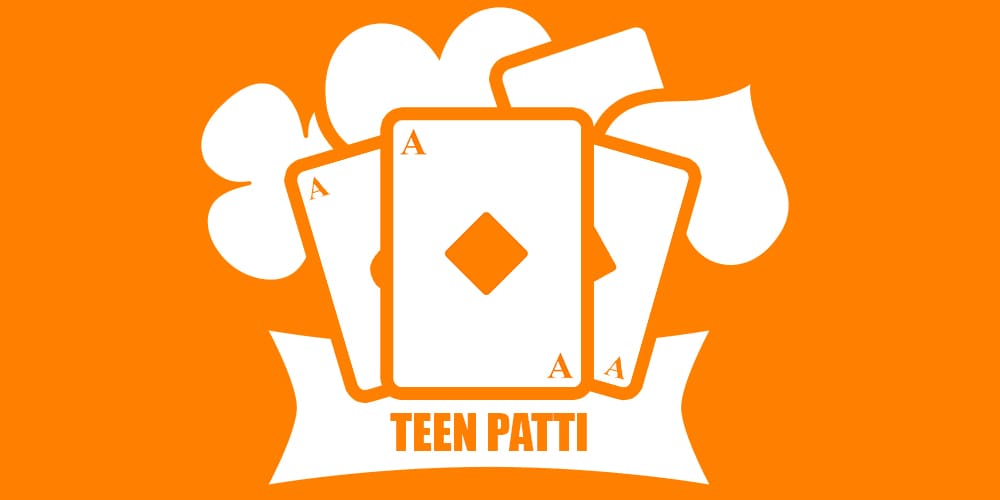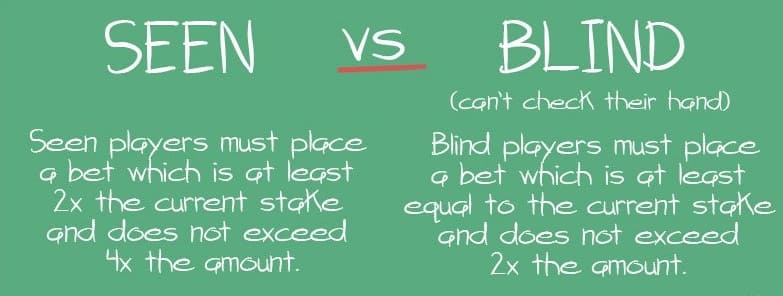Teen Patti, sometimes spelled Teen Pathi, means “three cards”. It is an Indian gambling game, also known as Flush (or Flash), and is almost identical to the British game 3 Card Brag. An international 52 card pack is used, cards ranking in the usual order from ace (high) down to two (low). Any reasonable number of players can take part; it is probably best for about 4 to 7 players.

Where to play Teen Patti online
[aces-casinos-4 items_number=”10″ external_link=”1″ items_id=” 47, 13, 111, 66, 1096, 72, 70, 68, 802, 1259″]
All casinos listed above are great for Indian players and for playing Teen Patti Online. Thanks to innovation, these games can be played online at any time and from anywhere in the world, provided you have access to the internet and a supported device.
Teen Patti Terminologies in India
Before we go ahead towards learning the Teen Patti game rules and strategies, let’s first look for the terms most frequently used in this Indian online game.
| Ante (Boot) | Post | Blind | Chaal – Call and Raise |
| Fixed Limit | Spread Limit | Pot Limit | No Limit |
| Sideshow | Blind Play | Show (down) | Fold (Pack) |
| Pure Sequence (Straight Flush/Pakki Round) | Trail (Three of a Kind)/Set/Trio | Sequence (Straight or Run) | Colour (Flush) |
| High Card | Pair (Two of a Kind) | Loose and Tight Play | Seen |
Probabilities
The probabilities of the various ranking combinations are described below. All these probabilities are described for 52-card teen patti, without the two Joker cards. In Joker versions, the probabilities change widely, most importantly for pairs.
There are 52 cards in the deck.
| Hand | Frequency | Probability | Cumulative Probability | Odds |
|---|---|---|---|---|
| Three of a kind/trio | 52 | 0.24% | 0.24% | 424.00:1 |
| Straight flush/pure sequence | 48 | 0.22% | 0.45% | 459.42:1 |
| Straight/sequence | 720 | 3.26% | 3.71% | 29.69:1 |
| Flush/colour | 1096 | 4.96% | 8.67% | 19.16:1 |
| Pair | 3744 | 16.94% | 25.61% | 4.90:1 |
| No pair/high card | 16440 | 74.39% | 100.00% | 0.34:1 |
| Total | 22,100 | 100.00% | 100.00% | 0.00:1 |
Playing Process
Although the probability of being dealt a pure sequence is slightly less than that of a trio, trios are considered higher hands in most versions of the game. Because of this variance from strict rarity, a popular house rule is to treat 2-3-5 of the same suit as a straight flush, thereby increasing the number of possible straight flushes to 52, the same as a trio, bringing the probabilities even.

The game starts to the left of the dealer and proceeds clockwise. After plays get their cards they make bets on who has the best hand. Before betting players can either bet blind, that is bet without seeing the cards or bet after looking. Players who bet without looking at their cards are blind players and players who look before betting are seen players. Bets go around the table as needed. Players have the option to bet nothing and fold. If a player decides to fold they lose all betting opportunities and sacrifice the money they put in the pot.
Blind Player
The blind players must not look at their cards before betting. To play blind place a bet in the pot. That bet must be equal to but not more than twice the total in the pot. If you are the first player, your bet must be at least equal to the boot.
Stake amount, a bet placed by a blind player becomes the stake amount the next player must match (or exceed). However, for seen players, the stake amount is only half their bet.
A blind player may ask for a show if they can. This is called a blind show, after which both players cards are made visible and the winner collects the pot. For there to be a show, situation must meet the following criteria
- All but two players must drop out
- If you are a blind player, the show costs the amount of the stake, no matter if the other player is blind or seen. The show must be paid for before you can look at your cards.
- Seen players are not allowed to ask for a show. They can either place bets or drop out.
- If both players are seen players, a show costs twice the amount currently staked. Either player may ask for a show.
- If after the show the hands are equal, the player who didn’t pay the pot for the show wins the hand.
Seen Player
Seen players can chaal, fold, show, or sideshow. After you look at your cards, to remain in the game seen players must play chaal.
To play chaal a seen player places a bet in the pot. This bet must be between twice and four times that of the current stake (or the boot if they are the first player). If the player before was blind their bet becomes the stake amount. If the player before was seen, half their bet becomes the stake amount.

A seen player may call for a show following the rules outlined above. They may also call for a sideshow. In a sideshow, a player is asking to compare their cards with the last players. This is only applicable if the previous player was a seen player and there are still 1+ players in the game. To ask for a sideshow place in the pot an amount double of the current stake. The previous player may accept or deny the sideshow.
If the previous player accepts the sideshow and has better cards, you must fold. If your cards are better, they must fold. After a player folds the turn passes to the next player.
If the previous player denies the sideshow, cards are not compared and play continues on.
What is Teen Patti for Players?

We have sat back and observed the game style of players I admire and then, am finally capable of playing the game at our will. This is why we would say that to me Teen Patti is a game of skill. However, it can definitely be a game of luck to others. The key to understanding, if the game is skill-based or luck-based for you, depends on the answer to this question We discovered — Do you control your game according to the cards or do you play the game according to your cards?
If you control the game according to the cards, then, you know when to and when not to increase your bets in the game. You also understand if your cards are good enough to bluff and secure a win. But when you play the game according to the cards, you often are driven away by the thrill of the game.
Now that it is not you but your excitement that is controlling your game, and you don’t know if the decision you will be making is actually what you want.
Be the first to comment